Discussion around Hydroviv vs Reverse Osmosis is always heated. That is because both are great contenders for undersink water filtration systems. However, these have attributes and drawbacks of their own.
Some households would benefit from a Hydroviv Water filter while others need RO. So which one should you buy? Let’s find out by assessing through the parameters!
Table of Contents
Quick Comparison
Hydroviv filters and RO Systems are both used to purify water from harmful contaminants. Yet they do the job differently. Let check out what is the main dissimilarity between the duo:
- Hydroviv: Hydroviv employs customized filters tailored to the specific contaminants found in your water. It’s designed for targeted filtration, addressing regional water quality issues efficiently. Installation is typically quick and DIY-friendly.
- RO (Reverse Osmosis): It uses an all-around approach to filtration. It removes a wide range of contaminants, including minerals, heavy metals, and microorganisms. Also, produces purified water at a slower rate compared to Hydroviv.
You know the surface-level detail right now. Continue reading where I explain which qualities matter the most when choosing between these. Which system is space-saving, pocket-friendly, and easy to install. Let’s head down to our 7-parameter detailed comparison.
Hydroviv vs Reverse Osmosis Comparison Chart
The best way to have an overview is by putting the specs side by side. Let’s see how they compare:
Comparison Factors | Hydroviv Filter System | Reverse Osmosis Filtration |
Brand: |  |  |
Annual Filter Replacement Costs: | $172.50 | $50- $100 |
Installation Process Time: | 15 Minutes | 1,5 – 2 hours |
Occupies Significant Space: | No | Yes |
Water Waste: | No | Yes |
NSF Certification: | 42 and 53 | 42 and 58 |
Removes Healthy Minerals: | No | Yes |
Removes PFAS: | Yes | Yes |
Removes Fluoride: | No | Yes |
Removes Lead, Arsenic, Chromium 6: | Yes | Yes |
Removes Bacteria: | Yes | Yes |
Hydroviv Reviews: Merits and Demerits
To help you have more clarity on Hydroviv Under Sink Water Filters, let’s check out its pros and cons.
Listed below are the positives of the Hydroviv:
- The filtration system is certified by NSF for meeting standards 42 and 53.
- The product is tailored to remove contaminants found in your area.
- It’s small, so it doesn’t take up much space.
- It has a 30-day money-back guarantee without any need for explanations.
- It includes an installation kit with all the parts you need.
- It can also filter well water.
Let’s check out the weak points too:
- You will not be able to purify drinking water from fluoride with this.
- It might be pricier than other sink water filters
Reverse Osmosis Filtration Systems Reviews: Merits and Demerits
Now we must look at the benefits and drawbacks of using reverse osmosis systems to see how they compete with their counterpart:
The following are the positives of RO Filtration:
- Reverse Osmosis Drinking System produces 99.9% pure water, enhancing taste and maximizing health benefits.
- You can avoid plastic. This system allows you to store water in glass, stainless steel, or BPA-free plastic.
- This under-counter water filter is thin and saves you much-needed storage space.
- Hassle-free installation as you won’t need extra tools. Everything is included in the kit.
- It is able to remove lead, nitrates, and other harmful contaminants.
- You will most likely find it budget-friendly.
Listed below are the downsides of this system:
- It takes quite some time to filter and produce filtered water.
- The filter replacement is needed bi-yearly.
An Insight into Hydroviv Under Sink Water Filter System
A Hydroviv Under Sink Filter is an excellent mechanism to produce purified and filtered tap water. The best thing is that their filtration is customized for each customer. That is to treat the water impurities they face especially.
The company analyzes the water quality in your area on the information available in your locality’s database and develops the filters accordingly.
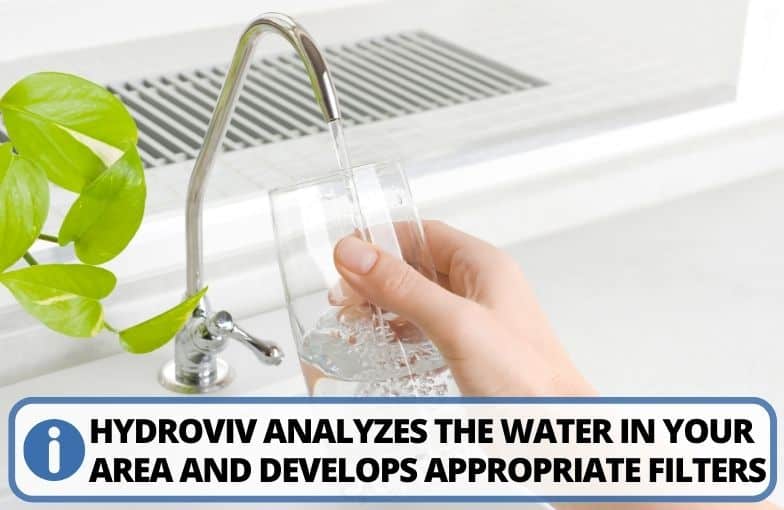
Let’s learn what else it can do:
- You will be able to save counter space due to its narrow body;
- Also, there is no worrying about filter changes for at least a year when using this;
- What sets it apart is it can be customized.
The filter system treats the specific metals found in your tap water. It can remove the following:
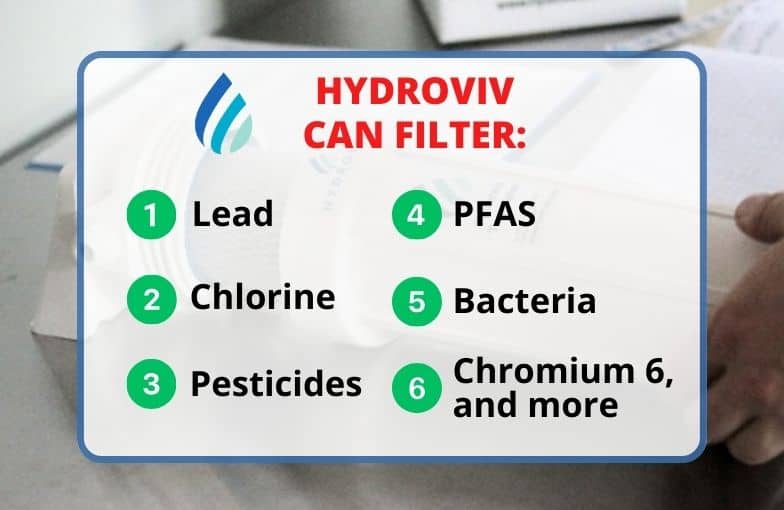
- Lead;
- Chlorine;
- Pesticides;
- Bacteria;
- PFAS;
- Chromium 6, and more.
An Insight into Reverse Osmosis Filtration Systems
Reverse osmosis (RO) filtration systems use a semi-permeable membrane to purify water. Tap water is pre-filtered, pressurized, and forced through the membrane. This blocks contaminants and allows only pure water molecules to pass.
However, the filter tank has residue of concentrated contaminants. So, you will need to flush that to keep it clean. Also, this results in reverse osmosis creating “waste water.”
Exploring the Kinds of RO Systems
There are two types of residential reverse osmosis systems:
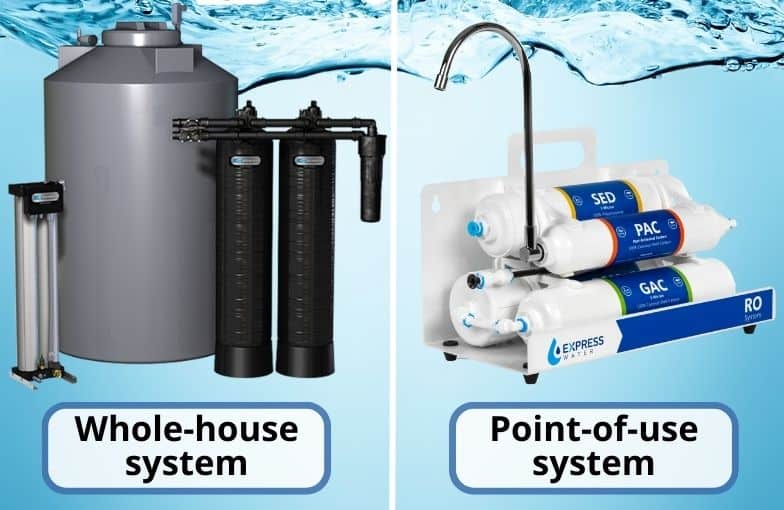
- Whole-house system: It is installed at the point of entry into the home.
- Point-of-use system: The more common type includes under-sink and countertop reverse osmosis systems.
Setting Up A RO Filtration System
Countertop RO units are very easy to set up. Plug them into an electrical socket and you are good to go. However, installing under-sink RO systems is slightly complicated as compared to Hydroviv. It has two types and I would recommend taking the help of a professional. Here’s a breakdown of the timeline:
- Tankless: It takes around 90 minutes to install this one.
- Tank-based: It takes around 2 hours to install.
Reverse Osmosis Lab Test Results
I put the Springwell Reverse Osmosis System to the test. The object was to check what it could remove from a cold water line and how good it was at the job. It effectively eliminated the following contaminants from the water sample:
- 95% of Bacteria, Total dissolved solids (TDS), Sodium;
- 85% of Chloride;
- 100% of Fluoride, Lithium, Radon, and Uranium.
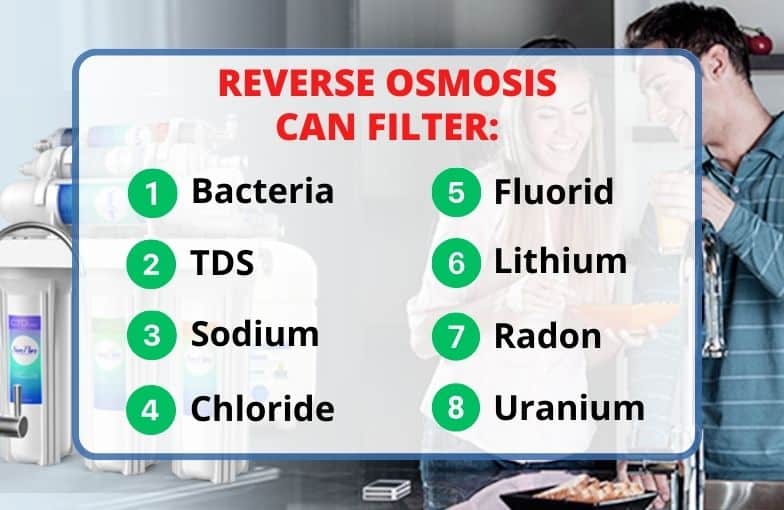
Hydroviv vs Reverse Osmosis Systems: A 7 Parameter Detailed Showdown!
Let’s put the types of under-sink systems against each other. We can conclude through the 7 factors to see which is better. Here we go!
1. The Capacity of Water Filtration
These steps can help you to find the best water filtration system in terms of capacity:
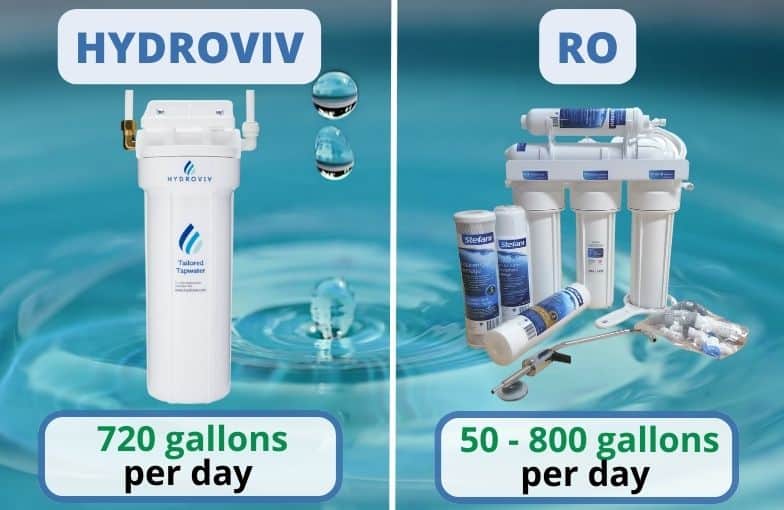
- Water Storage Tank: In terms of storing the water, reverse osmosis systems are on the top as their capacity can vary between 2 – 14 gallons. In contrast, Hydroviv filters don’t have storage tanks at all.
- Water Output Capacity: It is the amount of filtered water that a system can produce in a given time. Hydroviv systems usually have the capacity to filter 720 gallons per day (GPD). On the other hand, reverse osmosis has different capacities, ranging from 50 – 800 GPD.
Winner: It’s debatable which winner to pick here. If you prefer a fixed GPD capacity, you can go with Hydroviv. Whereas, RO systems offer different capacities based on variants. With some models, you can get up to 800 GPD. So, it depends upon your personal preferences and needs.
2. Filtration Efficiency
Hydroviv filters and RO filters are both great at filtration efficiency.
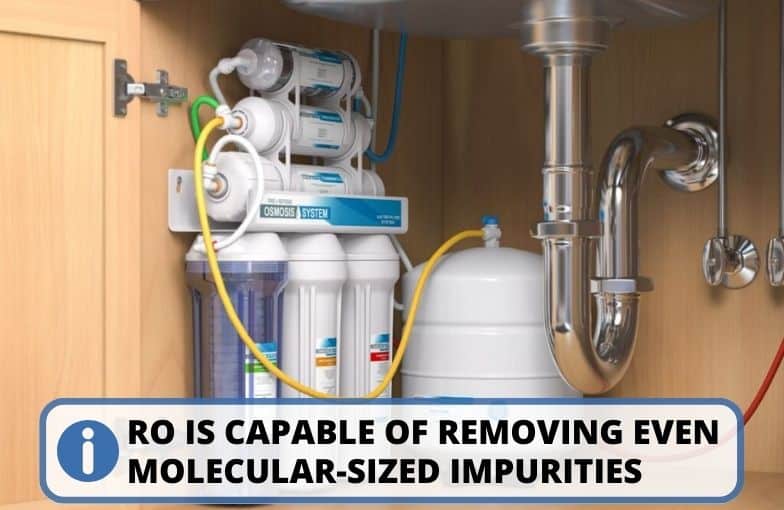
- Hydroviv: It is able to remove Lead, Arsenic, Chromium 6. As well as, bacteria, cysts, pesticides, VOCs, and more.
- RO: However, the reverse osmosis system is extremely effective. It has multiple stages to clean the impurities so even the molecular-sized ones are removed. It cleans away dissolved solids, heavy metals, pesticides, bacteria, viruses, and other harmful substances.
Winner: Due to its thorough filtration, RO stands victorious in this category.
3. Ease of Installation and Maintenance
Let’s look at how both these systems compare when it comes to ease of installation. As well as how frequently it needs filter changes:
- Ease of installation: Hydroviv offers a user-friendly installation process that typically requires only 15 minutes of light DIY effort. When it comes to reverse osmosis water filters, it depends on whether it is an under-sink system or a countertop one. The former requires proper installation and takes 1 to 2 hours. The latter is a hassle-free option and can be used immediately after plugging into a socket.
- Maintainance: When it comes to maintenance, RO only requires yearly filter replacements. It may require tank sanitization with water pressure in 6 to 12 months depending on the debris. On the other hand, Hydroviv’s filter change process is easy due to its cartridge-based filtration system. It allows you to change the filter with just a simple pull and swap. However, it needs to be changed every 6 months.
Winner: Hydroviv under-sink water filter wins with flying colors here. Its maintenance is hassle-free and pocket-friendly.
4. Space Requirements for Under Sink Water Filter
Hydroviv is more space-efficient compared to traditional reverse osmosis (RO) systems. That makes it a practical choice for those with space constraints. However, you should keep in mind that RO can be further classified into two types:
- Tank-based;
- Tankless which are approximately 75% smaller than tank-based ones.
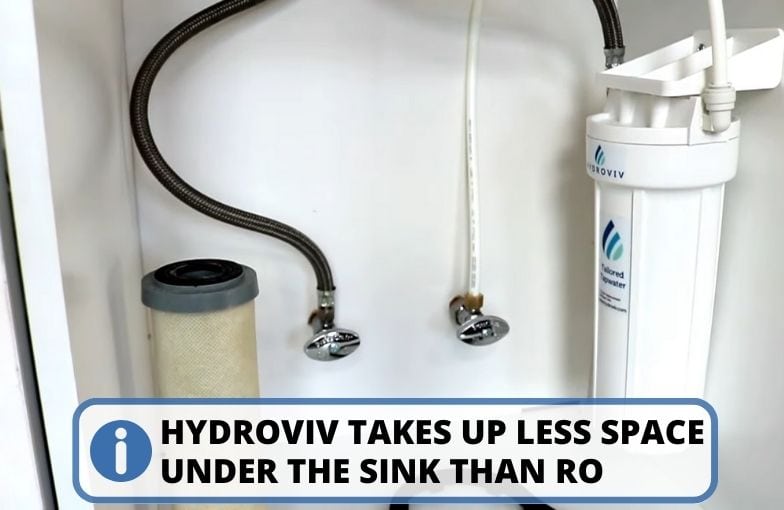
They use a powered internal pump, that creates pressure for efficient water processing. Hence they fit into smaller spaces more comfortably.
Winner: Hydroviv is the winner if we are only comparing it with tank-based reverse osmosis water filters. However, there isn’t much difference when we talk about tankless systems.
5. Filter Certifications
When you are in the market for better filtration, checking whether the system has appropriate certification or not is crucial. ANSI/NSF are the most reliable ones.
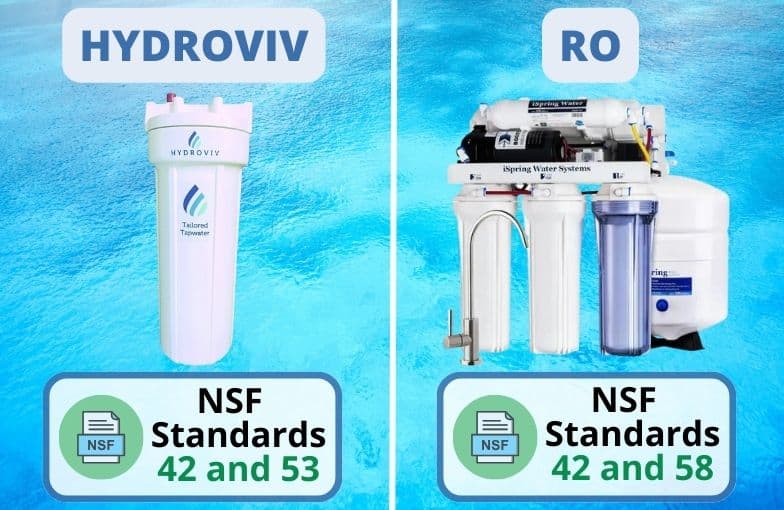
- Hydroviv holds NSF certification to Standards 42 and 53: “Standard 42″ means that the company’s claim to clean chlorine, taste and odor, chloramine, particulate, iron, manganese, zinc, and total dissolved solids is legit. “Standard 53” approves claims of other 50 contaminants including lead, cryptosporidium, VOCs, and chromium.
- RO filter systems would have standard 42 and 58 certifications: The same “Standard 42″ as for Hydroviv. “Standard 58” certification is for TDS (total dissolved solids) reduction but can also include Cyst, Barium, Copper, Fluoride, and other metals.
Winner: When it comes to certification both water filtration systems are safe and excellent for drinking water.
6. Price Factor
On average, reverse osmosis (RO) systems are a little pricier than Hydroviv filter systems. This is because RO systems boast a complex mechanism that involves semi-permeable membrane and post-filtration.
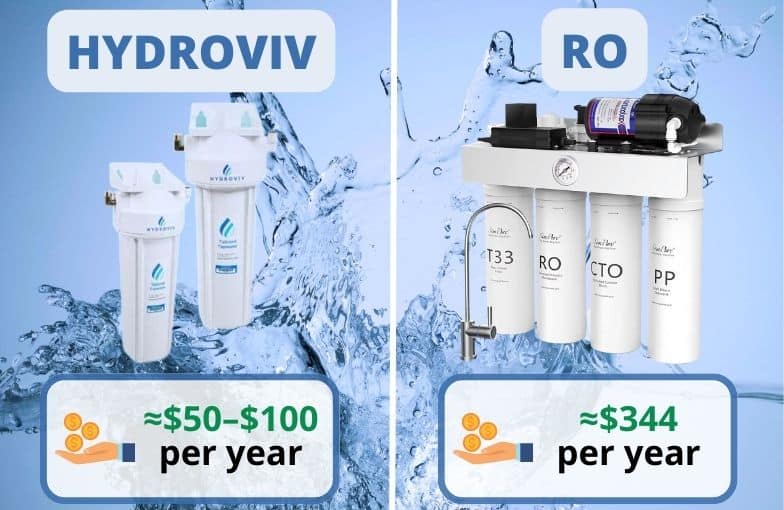
When it comes to maintenance costs, RO will have an expense of US $50- $100 a year while Hydroviv will have $172 every 6 months. On buying their subscription you can save 25%.
Winner: The RO water filtration system wins this round as the filter replacement cost is lower than the Hydroviv.
7. Complaints & Customer Service
Hydroviv has great products however not every unit can be perfect from many produced. This is why some consumers have a few complaints about Hydroviv. The common problems include:
- A leaking system;
- Difficulties with Mounting Unit.
But, the good thing is they offer a 30-day full refund policy and a 1-year limited warranty for customers. It also offers customer support through email, live chat, and phone for consumer assistance.
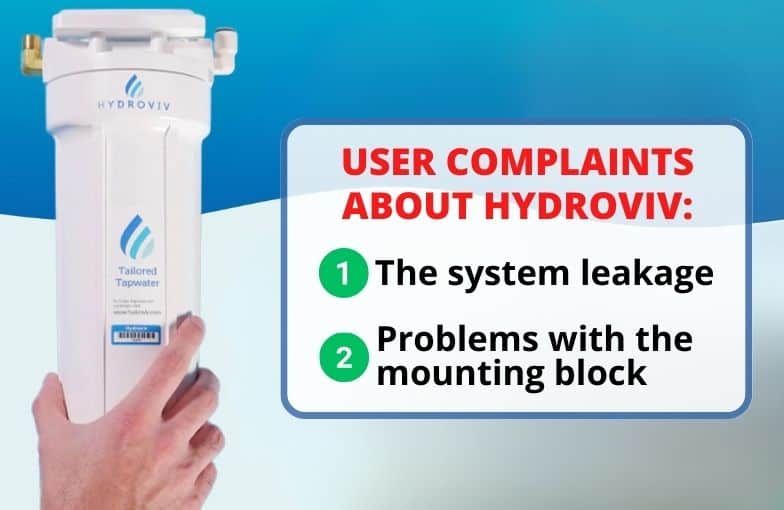
Reverse Osmosis is manufactured and sold by different brands. This is why the reviews, complaints, and quality can differ depending on it.
Winner: This specific category results in a draw. Hydroviv cares about its customers and produces top-notch products. Reliable RO vendors will have these qualities as well.
Hydroviv vs Reverse Osmosis Water Filters: Things to Know When Buying
If you are looking for a water filtration system, you might wonder which one is better. Here are some things to know when buying a water filter:

- Advanced technologies: Hydroviv filters use different filtration technologies, such as activated carbon, catalytic carbon, and ion exchange, to remove a wide range of minerals. Reverse Osmosis (RO) filters only use a semipermeable membrane to remove contaminants.
- Amount of wastewater: RO filters generate a significant amount of wastewater. This can be a concern in areas where water scarcity is an issue. On the other hand, Hydroviv filters do not waste a lot of water.
- Budget: Generally, RO filters tend to have a higher upfront cost due to the system’s complexity and installation process. However, the ongoing cost of replacing filters and membranes is less as compared to others. Hydroviv filters are typically replaced every six months, which may result in higher long-term costs than RO filters which can be $50- $100 per year.
- Retain beneficial minerals: Hydroviv filters are designed to retain beneficial minerals in the water, which can result in better-tasting water. On the other hand, RO filters are known for their thorough filtration, which can remove contaminants and essential minerals.
Final Verdict
Okay, now let’s go for the big question. Who should pick the Hydroviv filtration system and which households are better suited for Reverse osmosis under-sink water filter? Here’s a quick summary:
Parameter | Hydroviv | Reverse Osmosis |
Filter Capacity: | 5/5 | 4.5/5 |
Maintenance and Installation Process: | 5/5 | 4.5/5 |
Removal of Contaminants: | 4.5/5 | 5/5 |
Certification: | 4.7/5 | 5/5 |
Customer Service: | 5/5 | 4.7/5 |
The above table shows it’s a very close call between the two systems. So, let me make things simpler for you. You should buy Hydroviv if:
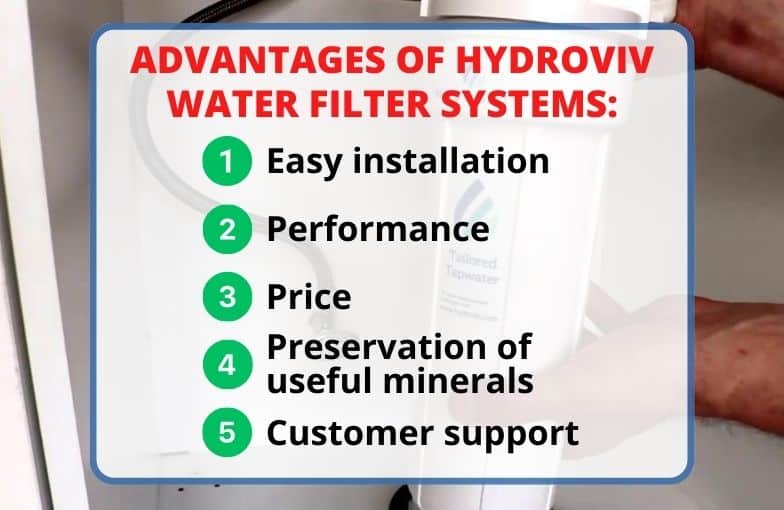
- You prefer easy and quick DIY installation.
- Have limited space and you need a compact filtration system.
- The water contains specific contaminants that Hydroviv’s custom filters are designed to address.
- You want an affordable option with lower initial costs.
- Value-responsive customer support and a 30-day refund policy.
Now view the following bullets and see if you are more suited for RO under sink water filter:

- Requires intricate water purification that can remove a wide range of contaminants.
- Your water quality is compromised by numerous contaminants. Including heavy metals, volatile organic compounds, chemicals, and microorganisms.
- If you are ok to invest in a more expensive system upfront for extensive contaminant removal.
- Have a big space for the installation, including room for a storage tank.
- You prioritize a trusted water purification technology with a proven track record.
FAQs
Is Hydroviv reverse osmosis?
No, Hydroviv does not use reverse osmosis. It uses various types of filtration media to clean the impurities from the tap water.
How long does a Hydroviv water filter last?
Hydroviv water filter last 6 months, under normal use. That is used for cooking and drinking.
Does Hydroviv remove good minerals?
Hydroviv does not remove good minerals. This is why its water tastes great.
Why doesn’t Hydroviv provide blanket lists of contaminants/percentages removed?
Hydroviv does not provide blanket lists of contaminants/percentages removed because each filter is customized for every customer. As every filter is tailored according to consumers’ needs putting a percentage on it will misguide them.
How Much Water Can An RO System Produce Each Day?
RO systems can produce from 50 to 75, or 100 gallons of water each day.
Is A Reverse Osmosis System Noisy?
A reverse osmosis system is not noisy. It only makes a slight humming noise during the water filtration process. However, if you are experiencing a loud whining sound, it can be due to the wrong installation.
How Is RO Water Compared To Bottled Water?
RO water when compared to bottled water has the same taste and cleanliness. In fact, it is better for one’s health, wallet, and the environment.
Conclusion
Summing up, while making a decision between Hydroviv vs reverse osmosis systems, you need to take care of a few things. Filtration efficiency, water waste, filtration capacity, ability to remove contaminants, and capacity to retain useful minerals are one of them.
Personally, I would love to go with Hydroviv filters. They are compact and easy to set up. They don’t cost much and the best thing is that their filtration is customized for each customer. That is to treat the water impurities specifically. Moreover, these systems also offer great-tasting water since the filtered water is enriched with useful minerals.
In contrast, a reverse osmosis system is also a good option. They are better at the filtration process, remove a wide range of salts, offer a large storage capacity, and have 42/58 certifications to guarantee effectiveness.

